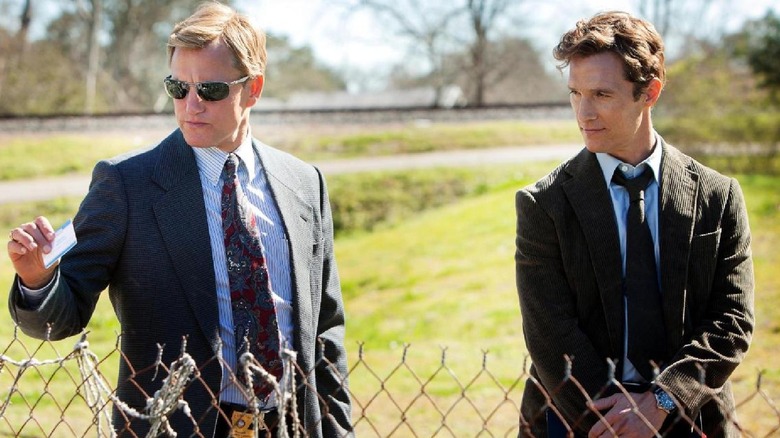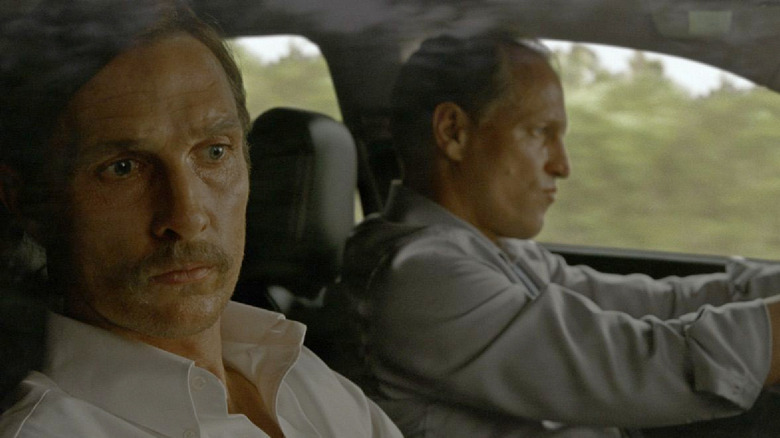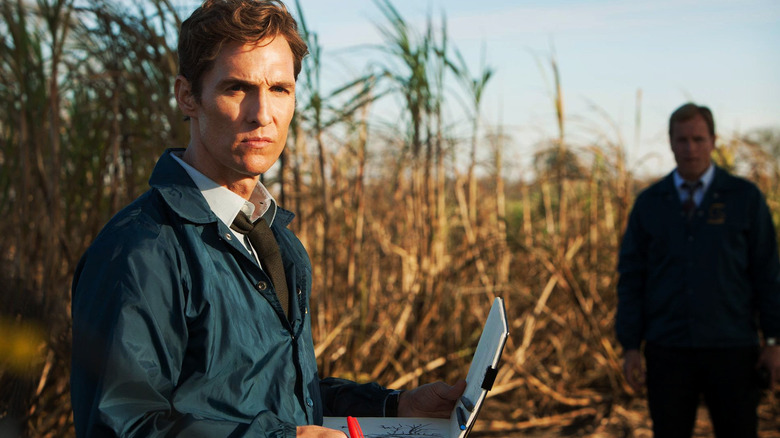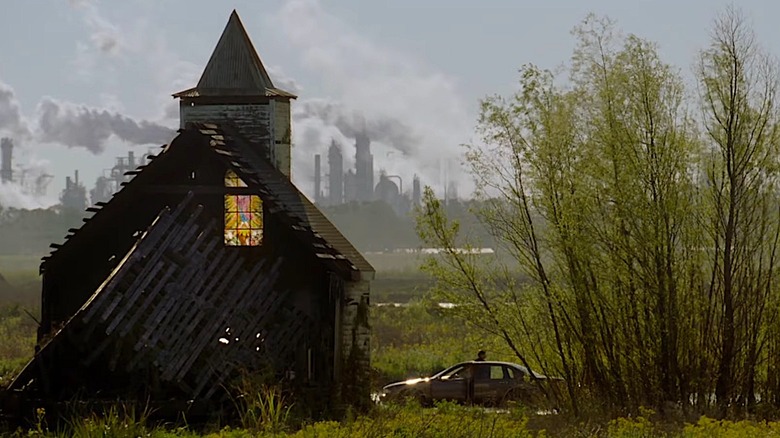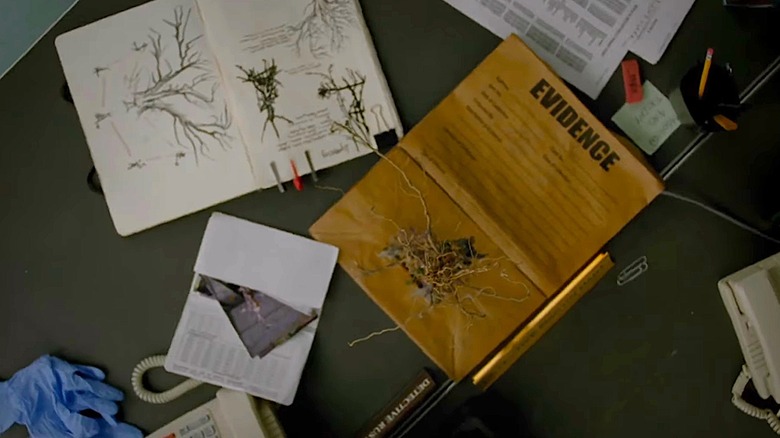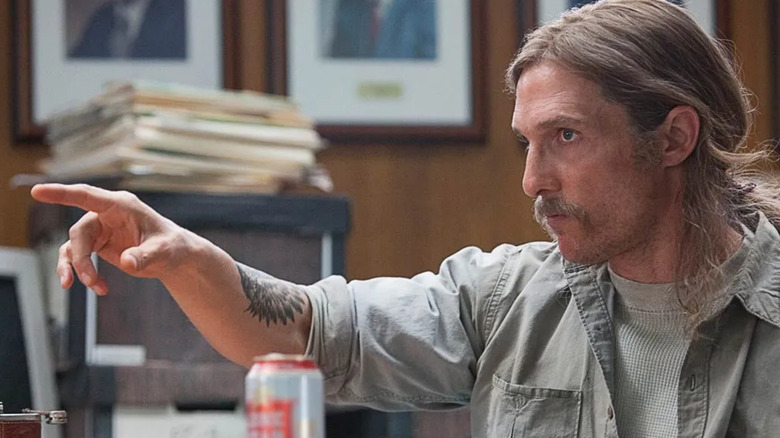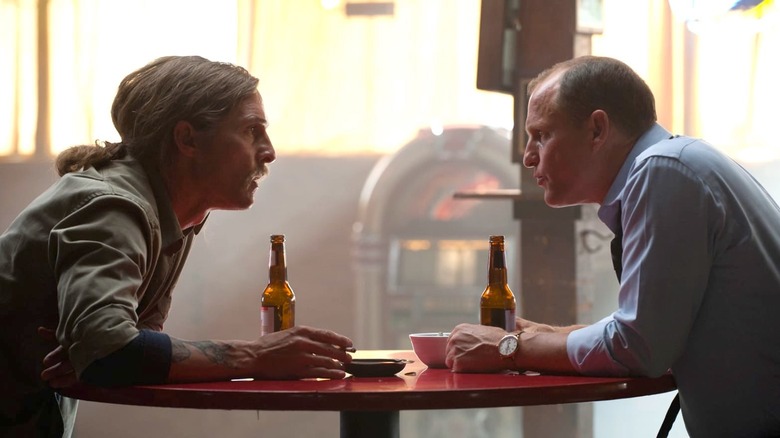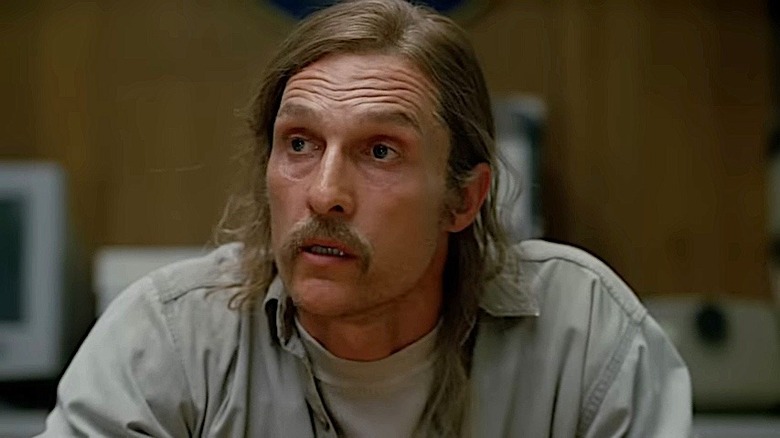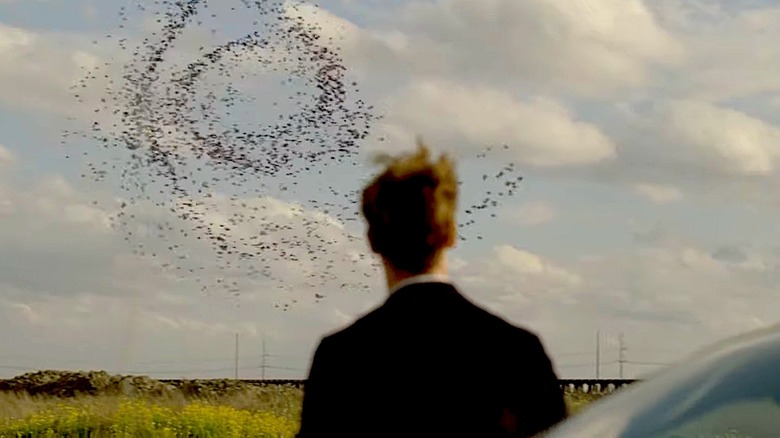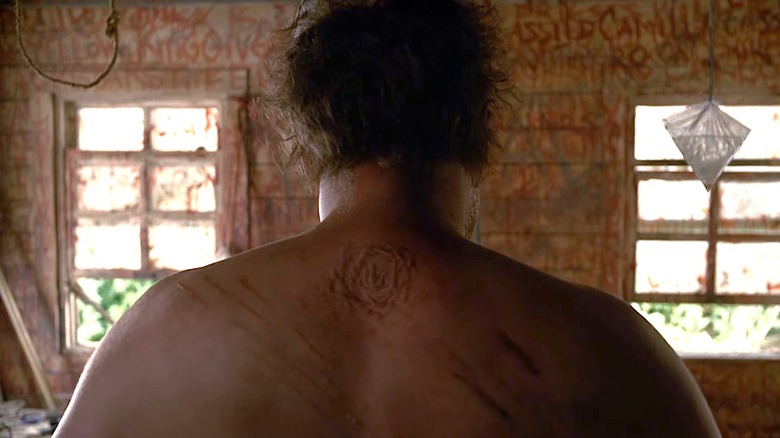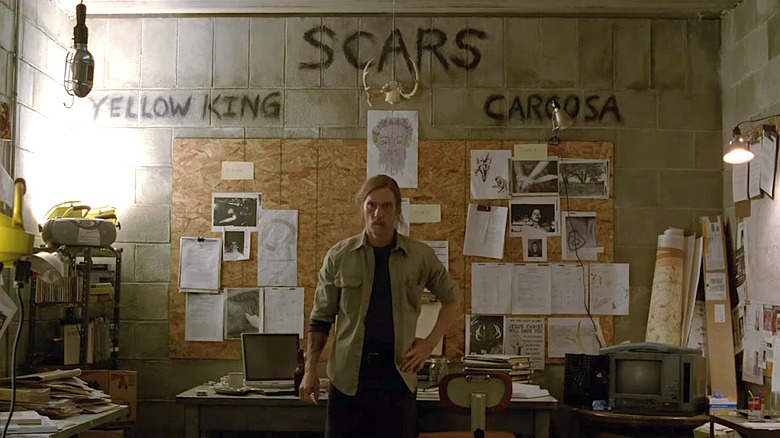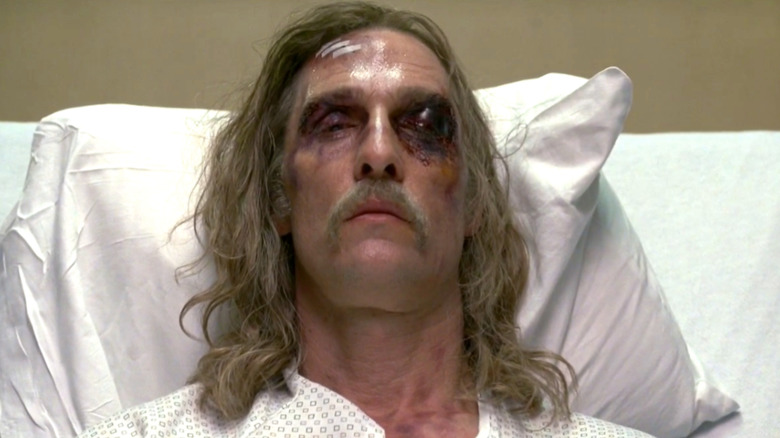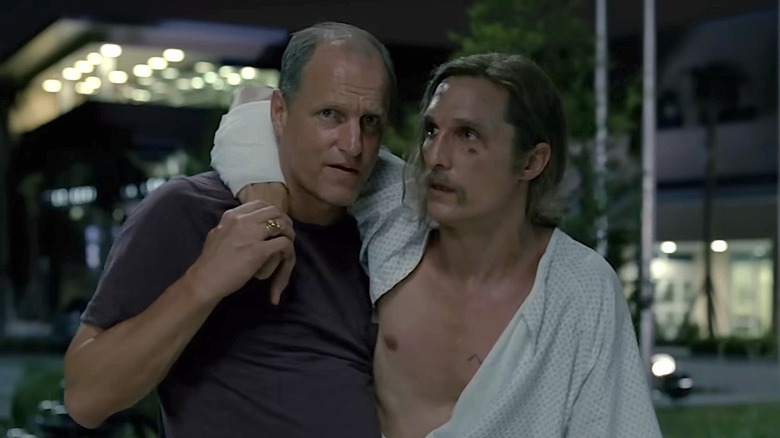The Ending Of True Detective Season 1 Explained
In 2014, HBO released the first season of the anthology crime drama series "True Detective," directed by "No Time to Die" helmer Cary Joji Fukunaga and starring Matthew McConaughey and Woody Harrelson as detectives Rust Cohle and Marty Hart, respectively. Season 1's eight episodes were lauded by critics, earning an 87% on Rotten Tomatoes with a 100% Audience Score. The show currently has a total of four seasons, with more always possible.
Set in Louisiana, "True Detective" Season 1 features a split timeline that slowly comes together over the course of the season. Beginning in 1995, Rust and Marty are brought on to solve the murder of a young woman named Dora Lange that appears to be ritualistic in nature. As this unfolds, the series jumps through time to 2012 when Rust and Marty, no longer in contact with one another after a falling out in 2002, are brought in for questioning on their old case, now reopened.
Over the course of the season, Rust and Marty face personal setbacks and moral questions as the case gets more and more complicated. A conspiracy unfolds surrounding a rumored "Yellow King" and a fictional city called "Carcosa," and the detectives connect other missing persons cases or murders to Lange's case. In the season finale, everyone is brought up to speed in 2012. Teaming up once again, Rust and Marty finally figure out the identity of the serial killer they've been hunting for almost two decades.
What happens at the end of True Detective Season 1?
After many years and an intense loss of optimism and belief in humanity, Rust and Marty now know who killed Lange and many others. Turns out they even met the man 17 years prior back in Episode 3, as the person on the lawnmower who Rust talks to at the school. His name is Errol Childress (Glenn Fleshler), the grandson of Sam Tuttle. He is the man with the scars on his face, the tall man, and the green-eared spaghetti monster all in one.
The detectives arrive at the killer's home and force their way in. When Errol doesn't listen to Rust and runs, Rust tracks the man through the house and across the property, seeing all the evidence of Errol's insanity. Eventually, the two arrive at a domed room that appears to be the mythical Carcosa. Rust then has a vision at the most inopportune moment, likely the result of years of drug use and other factors.
In the middle of his vision, Rust is viciously attacked by Errol and stabbed in the stomach. Despite Errol's size and Rust's new injury, the detective holds his own until Marty arrives and shoots the killer in the shoulder. Of course, Marty then suffers his own injury as Errol turns his attention on him. As Errol tries to kill him, it looks like Marty has little chance of surviving. Luckily for him, Rust manages to stay conscious long enough to shoot Errol in the head.
The Tuttle family cult and the real-life inspiration
With evidence from Errol's home, the police are able to connect him to the Lange case and many others over the years. Unfortunately, they are unable to solidly connect the crimes with the rest of the Tuttle family. Throughout the case, Rust and Marty uncover a cult operating within the Tuttle family, of which Errol is a member. The group worships the Yellow King and Carcosa, performing ritual torture and sacrifice of children. This is evident in the video of Marie Fontenot's death that Rust finds in the possession of Reverend Tuttle (Jay O. Sanders). Despite this piece of evidence, the police are unable to tie it to either the Tuttle megachurch or Senator Eddie Tuttle, leaving them free of consequence.
The real-life origin of the Yellow King and Carcosa is a book of short stories by author Robert W. Chambers called "The King in Yellow." The collection of dark stories revolves around a fictional in-universe play, also called "The King in Yellow," that causes anyone who reads it to go mad. Chambers depicts Carcosa in his work as an ancient, possibly cursed place. According to show creator Nic Pizzolatto, however, this source doesn't necessarily exist in the "True Detective" universe. As he told EW, "To be clear, in our show, nobody is going to reference a book by Robert Chambers called 'The King In Yellow.'" The show leaves clues here and there pointing to connections, but it's up to viewers to interpret how the cult formed around these beliefs.
Is the cult supernatural?
Back when "True Detective" Season 1 initially aired, you couldn't swing an ominous twig doll without hitting a message board full of Yellow King cult fan theories. The most popular of these was that the Tuttles and their fellow freaky friends committed ritualistic abuse and murder to worship a Lovecraftian god of time. While Nic Pizzolatto might have liked the cosmic horror vibe, he insisted that there is no such occult boogeyman to blame at the end of "True Detective."
"There are no monsters other than humans, no heroes other than humans," he told Entertainment Weekly, while discussing the finale. There were the Tuttles and their fellow monsters, who committed and covered up their crimes using a vast network of schools, churches, and positions of power — and there was the final "monster": Errol Childress. Errol may seem gifted with supernatural powers in the final episode, as he poetically taunts Rust, but this "monster" is really a man long abused by his own Childress/Tuttle family, who executes the same abuse himself.
Errol also seems to believe whatever mystical aspects the cult holds dear, and, per Pizzolatto, craves death and "ascension" to Carcosa at the hands of Cohle — as well as his own brand of justice. Pizzolatto told Entertainment Weekly that Erroll is the "dark mirror" to Rust and Marty, and "the historical victim of bad men who murders women and children," who "was signaling to the authorities both his presence and the presence of the men who made him."
Why is the cult so important?
"True Detective" Season 1 is a show in large part about belief and stories, and how believing in some stories can drive a man to madness — or some possibility of hope. The final episode is the only one to provide a POV character other than Rust or Marty: Errol. "You know what they did to me? What I will do to all the sons and daughters of man," Errol taunts Rust, from deep within the bowels of a Carcosa of his own making.
Errol's true belief in his family's cult adds an extra mutation to the already-horrific Tuttle cult conspiracy. When describing the mystical, religious ways he grew up to Buzzfeed, Pizzolatto said, "The wild extremes of belief were always visible, and then to me it's a short jump to a horror story ...The ritual abuse in our show is the darkest side of belief, in a show where belief has been a steady underlying topic."
The cult gets off easy in the ending of "True Detective" Season 1. Most Tuttles are dead or, aside from Errol, protected by their own wealth and political influence. Plus, the Tuttle name and their "crooked spiral cult" make appearances in other seasons of "True Detective," proving that cover-ups, conspiracies, and cults have a long life — and weave a wide, sinister web. As Marty tells Rust in the finale: "We ain't gonna get 'em all. That ain't what kind of world it is, but we got ours."
Rust Cohle regains hope for the world
While the final episode wraps up the case, it also brings some resolution to the characters of Marty and Rust. Throughout the show, Rust is a stark nihilist with little hope in humanity, and this affects his relationships — or lack thereof — with those around him. As he recovers from his almost fatal encounter with Errol, Rust explains to Marty what it felt like being that close to death. Like the vision of oblivion he sees before he is stabbed, Rust says, "I could feel my definitions fading. And beneath that ... darkness, there was another kind. It was — it was deeper, warm, you know, like a substance. I could feel, man, and I knew, I knew my daughter waited for me there." He talks about feeling like all he "had to do was let go," and he does. But despite all that, he wakes up, alive.
While it seems like Rust wants to die in that moment, his attitude after his survival is completely changed, as if that one moment feeling a connection to his deceased daughter gives him the motivation to live again. In the final moments of the season, Rust illustrates this newfound perspective, saying "Once there was only dark. If you ask me, the light's winning." Does this mean that the man who continually scoffs at religion and faith has finally found meaning for his life and something to believe in? Well, that's up to your interpretation.
Marty Hart stays by Rust's side
Marty is just as self-destructive as Rust throughout the season, though it presents itself in different ways. Initially, his life looks picture-perfect, but as the episodes continue, "True Detective" quickly reveals that it is anything but. In 1995, Marty is having an affair with a younger woman named Lisa (Alexandra Daddario) and going through a midlife crisis. Soon, his wife Maggie (Michelle Monaghan) finds out, and she takes off with their daughters.
Unsurprisingly, the one thing Marty manages to keep control over is his reputation at work, following strict regulations and maintaining good relationships with his colleagues. It's a good thing, because after Maggie leaves, this is all he has left. At the end of the season, Marty is still alone with his work, but with the help of Rust he finally solves the case that's been hounding him for years.
Marty then stays with Rust as he recovers from his injuries, keeping a close eye on him and promising that his living situation once he gets out is all set up. As he listens to one last philosophical speech from Rust, the two appear to actually be friends now. Although the finale leaves no hints as to what the two detectives will do next, at least audiences can rest easy knowing they have each other.
Is time a flat circle?
Rust Cohle's philosophical musings throughout "True Detective" have made some people really think — and some (including Marty Hart) roll their eyes. "Time is a flat circle," insists Rust early in the season, during his 2012 timeline interview. "Everything we've ever done or will do, we're gonna do over and over and over and over again ... forever." Cohle's line, borrowed from philosopher Friedrich Nietschze, is now as burned into pop culture as his Big Hug Mug. How does that philosophy play out in the end (or should we say, beginning?) of "True Detective" Season 1?
Nietschze's idea of living in an infinite time loop, or "eternal return," is well summarized by the younger, nihilistic Rust. The entire season, Rust craves death and an exit from the endlessly repeating, redemption-less cycle of his life and the crimes he feels compelled to solve, especially since losing his daughter. However, Rust's near-death experience with Errol, being saved by Marty while in turn saving Marty's life, and experiencing a vision of his family in some world beyond give Rust a new, if only marginally sunnier, lease on life.
Per Nic Pizzolatto, this slight unflattening of the circle was intended from the very beginning. He told HitFix: "This is a story that began with its ending in mind, that Cohle would be articulating, without sentimentality or illusion, an actual kind of optimism. That line, you ask me, the light's winning, that was one of the key pieces of dialogue that existed at the very beginning of the series' conception."
How about them spirals?
A major visual motif in the series, the spooky little spirals of the Carcosa cult are a big mystery in "True Detective" Season 1. While it's clear that the spirals are a big deal for the worshipers of the Yellow King, it's unclear why that shape is so significant to the cult members — or "True Detective" on the whole. The big finale reveal of Errol and his lair show that much of the strange art and twig-dolls are his doing — as well as, likely, the markings left on his recent victims. However, Errol also bears the spiral marking on his own back, in that hard-to-self-tattoo spot between the shoulder blades.
In addition to the spirals, the show also uses black stars, dolls, and the number 5 in different compositions. What does it all mean? And does it actually mean anything? "Most of that was definitely deliberate ... Some of it wasn't intentional," director Cary Fukinaga explained to Vulture about the heavy dose of symbols used in the show. He described how the excitement over the show's original week-to-week release likely created "clues" where there were none — but also discussed a very deliberate spiral at the end of "True Detective" Season 1: Rust's final vision.
"We landed on the spiral formation of the clouds as a wrapping-up of the symbology, or at least a book-ending of the symbology," Fukunaga said. Of course, the "True Detective" symbology doesn't necessarily fully end there — as any viewer of "True Detective: Night Country" can attest.
The writer had ideas for alternate endings
Many message board maniacs have claimed that "True Detective" writer Nic Pizzolatto's "original" ending for Season 1 was scrapped in favor of the more "upbeat" ending that did air. However, Pizzolatto insists that the ending that aired is the ending he wanted, though he did have a few other ideas.
"It would have been the easiest thing in the world to kill one or both of these guys," he told Hitfix about the idea of having Errol defeat Marty and Rust, leaving Gilbough and Papania a mess to clean up — and cover up — themselves. He also described how he could have gone "full blown supernatural," but that to make either of these choices wouldn't have served the story of "True Detective" Season 1 as well as the actual, more realistic ending he wrote.
"Both these men are left in a place of deliverance, a place where even Cohle might be able to acknowledge the possibility of grace in the world," Pizzolatto said. "I don't mean that in a religious sense. Where we leave Cohle, this man hasn't made a 180 change or anything like that. He's moved maybe 5 degrees on the meter." Five degrees, when it comes to the calibration of Rust Cohle's keen and formerly death-craving, super-nihilistic mind, makes all the difference.
Some changes did happen from script to screen
According to director Cary Fukunaga, some changes did happen between the completion of Pizzolatto's script for the finale of "True Detective" and shooting the final scenes — namely, the location.
When a cypress forest couldn't be found for the showdown between Rust, Errol, and Marty, as scripted, Fukunaga and his team adapted the use of a real 19th-century fort for Errol's labyrinthine lair. Louisiana's Fort Macomb stands in for Errol's homegrown house of horrors.
Fukunaga pitched it to Pizzolatto as a factory that the Yellow King cult (and later, Errol) had taken over to ensnare victims. "There was a bridal path described in the script that a larger section of chambers in the fort worked perfectly for," Fukunaga told Vulture. "It's hard to tell but there's a spiral-like nature to the maze.and once you get to the final section before the altar room, the funnel grows smaller and smaller and smaller. I kept using the rooms that led downstairs. By the last part, it's almost like a womb. We did have to build the final octagonal altar room." Leave it to the "True Detective" team to blend real-life and imagined horrors to help make spirals even more terrifying to their audience.
Is Rust Cohle's story really over?
At the end of "True Detective" Season 1, Rust is a broken, but slightly revived, man. Where does he go from there? It's left up to viewers' imaginations, but Matthew McConaughey has a special love for the role of Rust Cohle. In 2016, McConaughey said on The Rich Eisen Show (via Entertainment Weekly): "I miss Rust Cohle, man." He added that he would consider returning to the role, and had talked with Pizzolatto about options, saying, "It would have to be the right context, the right way."
In 2023, "True Detective: Night Country" incorporated some aspects of Cohle's family origin story in its own plotline — which was written by a different team, and not Pizzolatto. Pizzolatto doesn't seem happy with this, per some comments on X (formerly Twitter) and Instagram — but the theme of interconnectedness and cycles always repeating seems tied to the original ending of "True Detective" Season 1.
"If there was one overarching theme to 'True Detective,' I would say it was that as human beings, we are nothing but the stories we live and die by — so you'd better be careful what stories you tell yourself," Pizzolatto told Hitfix. In 2014 Pizzolatto confirmed to Entertainment Weekly that he retained the literary rights to his characters, Rust Cohle and Marty Hart, saying, "Maybe you will see Cohle and Hart novels down the road after Hollywood kicks me out. Always a possibility."
How did fans and critics respond to the ending?
"True Detective" ushered in a new era of high-star-power, low-episode-count TV. It also captured the pop cultural consciousness so thoroughly that seemingly everyone had a theory about who The Yellow King would turn out to be. That's a lot of pressure on an ending. While many now revere the ending and consider the entire first season of "True Detective" as a masterpiece, message board mega-fans at the time didn't always agree, especially according to Reddit.
The "happy" ending of the series went down differently depending on the fan — as well as the critic. "I am a little in awe of how totally snookered we all were. Boy, did we overthink this thing!" Willa Paskin said in Slate. Joanna Robinson at Vanity Fair said: "Like Rust and Marty, the audience has been chasing the wrong demon. The terror and the darkness isn't external, it's internal. When you view it that way, the finale delivers an entirely satisfying conclusion."
Jeff Jensen at Entertainment Weekly agreed — with a some Rust Cohle-ian flair: "The final 15 minutes of 'Form and Void' struck me as a Rorschach test for what you want from stories like this, for what we've come to call 'resolution,' and boy, did we get a lot of it, both implied and explicitly stated, no more so during the last scene, with all of its mansplaining and bromantic uplift." Well, who doesn't want their grim mystery TV tinged with a little true bromance?
